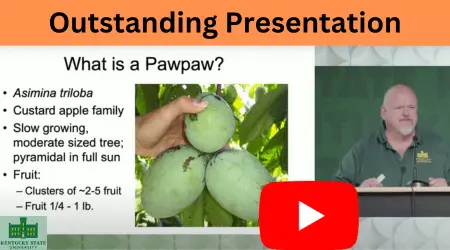How To Grow Pawpaw (Asimina triloba)
Pawpaw trees produce the largest fruit native to North America. The fruit’s texture is like custard, and has a tropical fruit flavor. Pawpaw (Asimina triloba) grow wild in 26 U.S. States. You’ll find these trees near rivers & streams, or in ravines (hollers). However, the tree can be grown in all US States! The name is also spelled, Paw Paw. The Latin name is, Asimina triloba.
See us on YouTube — please subscribe!
Pawpaw Plant Guide
1. Ten (10) Reasons why YOU should know the Pawpaw.
2. Fact Sheet.
3. Two type of Pawpaw Trees.
4. Pawpaw in landscaping and garden ideas.
5. Pick and Eat Pawpaw fruit.
6. Pawpaw health benefits.
7. Selling Pawpaw products.
8. Care and Maintenance.
9. Propagating.
10. Varieties of Pawpaw we grow organically right now!
11. A list of Pawpaw Festivals.
________________________________________
see our list of 400 edible plants
YouTube channel (please subscribe)
YouTube playlist for all our vid’s on Pawpaw (subscribe!)
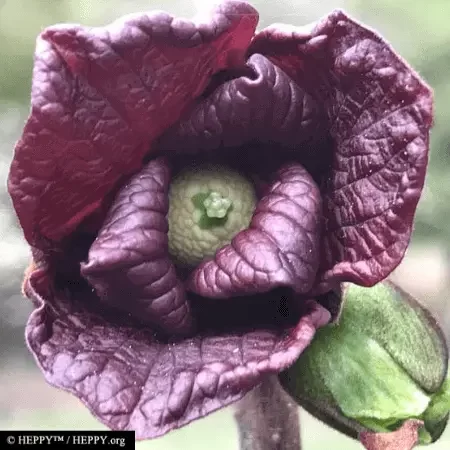
10 Reasons why YOU should know the Pawpaw
- Pawpaw is 100% American. Native Americans and American Pioneers relied on the fruit.
- A LOW care fruit tree. Very little pruning is needed and is largely pest & disease free. Once established, little or no water is needed.
- Completely deer resistant. Deer do NOT eat this fruit tree! Damn deer….
- Trees are visually attractive. They grow in a pyramid-like shape and are draped with large dark green leaves.
- Pawpaw fruit is healthy! It contains all essential amino acids, is high in minerals, and provides many vitamins.
- Pawpaw fruit is tasty! What grows wild in the States that has hints of mango, pineapple, banana, or orange-citrusy flavors!
- Pawpaw trees have anti-cancer properties.
- Strong commercial properties. Pawpaw trees, fruit and seeds sell! Commercial opportunity includes supplying quality trees at scale.
- Pawpaw trees can be planted & grown in any US State! It grows wild (natively) in 26 US States!
- Virtually NO one knows about the Pawpaw 🙁. So check-out a Pawpaw Festival, and be part of a very cool community!
Pawpaw is the most interesting fruit tree in North America — period! It’s considered an exotic fruit.
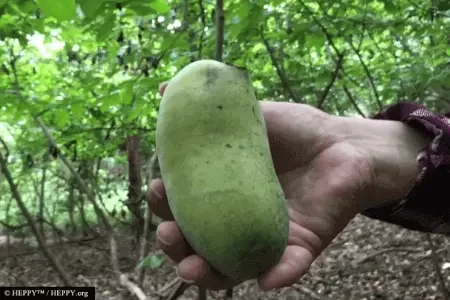

Pawpaw Fact Sheet
Pawpaw, Asimina triloba
common names: false banana, pawpaw apple, custard apple, custard banana, Poor Man’s Banana, banana tree, Indiana banana, Nebraska banana, Hoosier banana, Michigan banana, white plum, paw paw
Fact Sheet
Zone: 5 to 9 (individual cultivars vary)
Height: 15 to 30 feet (cultivars vary, usually below 20’)
Native: North America
Bloom Time: April – May
Bloom Color: dark maroon
Fruit Maturity: Aug – Nov (depending on zone and cultivar)
Self-fertile: no (two varieties are required)
Sun: full shade to full sun (protection needed in full sun)
Water: medium (will tolerate drought and occasional wet soil)
Soil: forgiving (wide range but prefers high-organic)
Maintenance: low
Growth Rate: modest
Deciduous or evergreen: deciduous
Edible¹: fruit (more information is below)
Medicinal²: yes (discussed below)
Commercial viability: strong (discussed below)
Family / Genus: Annonaceae / Asimina
Remarks: produces a very tasty tropical fruit; I’ve seen NO herbivory by deer; very important wildlife food; high-end price for tree products; pest and disease resistant
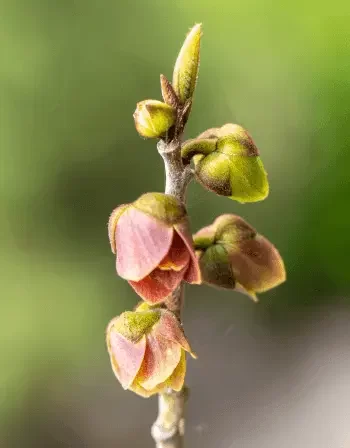
As an Amazon Associate, HEPPY earns from qualifying purchases (paid link).
Two types of Pawpaw trees
Pawpaw trees are either a cultivated variety (a “cultivar”) or wild (native). The main differences are fruit size, pulp-to-seed ratio, and volume-of-production.
Cultivars
Cultivars consistently produce much larger fruit, and have more pulp (vs seeds). They generally have many more fruit per tree than native trees. Finally, cultivars will begin fruiting in a few years. Native trees can take many years before producing fruit.
Pawpaw cultivation
Cultivation of this tree has a ridiculously brief history. Few professionals cultivated this incredible tree. Individuals such a Davis, Lehman, Peterson, and Zimmerman have. You can find cultivars named after them. Jerry Lehman named trees after his experimental plots, and then gave them a “proper” name. We grow the Jerry Lehman 250-39 that was named, Jerry’s Big Girl. Neal Peterson (Peterson Pawpaws) are named after rivers in his region. Finally, the Kentucky State University is very active in research and has introduced cultivars too.
What can cultivars do for me?
Cultivated trees produce two-to-four times larger fruit than native trees. Also, the fruit is … fruiter. The professionals call it the seed-to-pulp ratio. Fruit from cultivated trees produce a seed-to-pulp ratio of 10-15%. Fruit from native trees varies greatly but generally, 40-70%. For comparison, Avocados have a ~25% seed-to-pulp ratio.
One note: Cultivated trees are grown in full sun and native trees grow in shade. Fruit trees will flower & fruit far better in full sun.
Native trees produce wonderful fruit. Cultivars provide a better version of the native fruit.
Native
Native trees grow in the understory of a forest. The lack of sun influences fruit production. However, look for native trees on the sunny side of a stream or patch. They will be loaded with large fruit (and small ones 😉
Where to find native Pawpaw trees
A patch of native trees can be found everywhere. They grow along a busy road where I live! The patch can be small or stretch for miles!
Find them along established rivers and streams, and in little ravines (like “hollers” in KY). They grow wild in low-lying areas.
Locally, they grow along most of the Potomac River. North of Washington DC is the Chesapeake & Ohio Canal. It’s LOADED with mature native trees. We have two patches of native trees only 10 miles South of the US Capitol. One pawpaw patch — maybe a mile long — grows along a local river. The second patch grows along a small stream here in town! a 5 minute walk from HEPPY™.
Identify native Pawpaw trees and fruit
Easily identifying native trees and fruit. In late March they develop a distinct maroon-colored flower. It’s larger than a quarter ($0.25 piece). There’s nothing else like it. Starting mid-April you’ll see a distinct pointy leaf-bud at the tip of each branch tip. By May you see large, dark-green drooping leaves. It may be the largest-leafed understory plant! Hard to miss. The size of native trees is from 1 foot to 30 feet tall.
Look for mango or kidney shaped fruit. In May/June they are small and shaped like a banana, cucumber or mango. The color is all green. By August, you can’t miss them! There’s what fresh picked fruit look like.
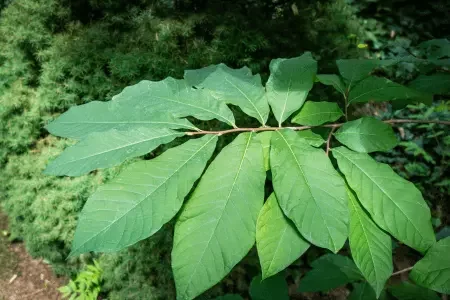

Picking Pawpaw fruit from native trees
Native Pawpaw fruit ripen in August through September. We are in zone 7, so late-August is prime picking time.
Ripe fruit are a little soft to the touch. They will have yellow hues in the skin. Dark spots and blotches on the skin is not uncommon. The spots have NO affect on the fruit quality. In fact, the discoloration tells you that the fruit is ready to pick! They don’t hang on the tree when over-ripe. In fact, you may find IDEAL fruit on the ground, if the fruit dropped within a day or two!
Bring bags! One tree can fill-up a grocery bag. I recommend to have many bags. Don’t overfill a bag. The fruit has thin skin and prone to bruising. Also, the fruit is heavy. Too many fruit in one bag will damage the fruit.
See fruit high in the tree? Gently shake the tree’s trunk BUT watch and listen and … LOOK OUT for dropping fruit!
A heavy shake is no good — it will get you unripe fruit and they don’t ripen well.
Native AND cultivar fruit have a wide variety of flavors: banana, mango, pineapple, or citrusy. Some wild trees produce exceptionally rich flavored fruit. We found a native tree producing citrusy-tasting fruit along the Chesapeake & Ohio Canal. It was an AMAZING flavor!
Pawpaw landscaping and garden ideas
Cultivars may grow tall and some more compact. But one thing is for sure — the trees are visually attractive. They grow in a pyramid-like shape and are draped with large dark green leaves. In nature, the tree grows in the understory. However, it adapts to full sun perfectly fine but must be shaded and watered. See Pawpaw Care and Maintenance.
Landscape Architecture
The treee are a perfect single accent tree in landscape architecture. Plant them in the center or corner of a front yard or backyard. They can be planted in a row to line a fence or, to be the fence.
It grow in full shade; however, the tree will grow lanky, and will produce less fruit. In medium or full sun, the tree will adorn itself with large, mildly drooping, oblong-shaped dark-green leaves.
Garden Ideas
Pawpaw are super low maintenance. They grow in shade, part shade and full sun. So any location works. They grow best in well drained, rich soil. However, they tolerate poor soils. I’ve seen trees grow along steep rocky hills away from water, and in flat clay-ladened soil along brackish water. But, the richer the soil, the less watering is needed. HEPPY plants trees in heavy organic material.
Pawpaw are highly adaptive; native Pawpaws have a wide range but cultivars will adapt to ANY State

As an Amazon Associate, HEPPY earns from qualifying purchases (paid link).
Picking and Eating Pawpaw Fruit
HEPPY™ cannot take any responsibility for any adverse effects from the use of plants. Always seek advice from a professional before using a plant for food or medicinally. This information is intended for educational purposes only and should not be considered as a recommendation or an endorsement of any particular medical or health treatment.
Pick a perfect Pawpaw
Is the fruit ripe? Looks at the skin color and the fruit a gentle squeeze. Unripe fruit do not ripen well. Pick ripe fruit — it’s worth it!
Squeeze the fruit
Ripe fruit are a little soft when gently squeezed. Fruit are ripe when your finger leaves a little dimple in the fruit. Also, immature fruit have green skin. However, ripe fruit have skin of yellow hues, and dark spots or blotches on the skin.
Alternatively, see expert Pawpaw farmer Jim Davis. See Jim’s ‘squeeze’ on Maryland Farm and Harvest episode 413 (22:38 [minute:second]). Jim & Donna Davis of Deep Run Orchard grow the fruit professionally.
Over-ripe fruit does not hang on the tree. So if it’s August-September, and fruit is on the tree with skin that yellow’ish, then give ’em a squeeze. The fruit will fall right into your hands if it’s ripe!
Pawpaw fruit: tropical flavored with custard texture
Ripe fruit has incredible flavor and texture.
Fruit flavor
Fruit have ‘hints’ of mango, pineapple, banana, or orange-citrusy flavors. Specific trees have a unique flavor profile (whether in the wild or as a cultivar). Also, fruit flavor may be subtle or overt (eg, clear mango’y). You can experience the many flavors when eating fruit from across a large native stand, such as along the Potomac River.
Fruit color
Pawpaw fruit flesh vary in color. Flesh is either off-white, hints of yellow, yellow, and totally orange in color.
Fruit texture
Fruit texture is consistently creamy and custard-like.
Eating Pawpaw
Eat fresh
The fruit is eaten fresh but more can be done! Run a knife gently around the fruit length-wise. Then theist & open! Watch us cut-open and eat our fruit!
Make beer, cake, ice cream, and more
Fruit is used in making beer, cakes & quick breads, cookies, custards, ice cream, and pies. Pawpaw pulp freezes well. That allows a lot of flexibility.
Pawpaw Recipes
Many recipes are provided by the University of Kentucky. Many types of pies, custards, cookies, cake, ice cream, pudding, jam, sherbet, punch, and zabaglione! All on one ad-free webpage!
Recipes from the Native Fruit Association look promising! Canning recipe, ice cream or pudding (no-churn, no eggs), mousse, no-bake cheesecake, oatmeal bars, and smoothies.
Storing Pawpaw
Store picked fruit
Fresh fruit does not store well. Refrigerate fruit after picking. They may last 5-10 days. Fruit may last 1-3 days outside the fridge.
Freeze fruit pulp
The pulp is fruit without the skin or seeds. Thankfully, the pulp freezes very well! The pulp is presently the industry’s predominant product (Sarah Francino, OSU PhD candidate). However, the process is labor intensive. Separating the pulp from seeds and skin takes a little effort.
As an Amazon Associate, HEPPY earns from qualifying purchases (paid link).
Pawpaw Health Benefits
Healthy fruit
Pawpaw fruit is very healthy, antioxidant-rich fruit. The fruit has MANY times more minerals and vitamins than banana, apple, or orange.
Health benefits include:
- It has all essential amino acids.
- High source of minerals including calcium, copper, iron, magnesium, manganese, phosphorus, and zinc.
- High source of vitamins including vitamin C, riboflavin and niacin.
- Fatty acids are better than the banana.
Medicinal qualities
Medicinally, the tree is a giant (very much like the other native nutritional ‘giant’, the Persimmon).
Dr. Jerry McLaughlin dedicated his career to how the Pawpaw works against cancer cells. Dr. McLaughlin is a Professor of Pharmacognosy at the University of Michigan, University of Washington, and Purdue University.
This study found “that pawpaw extracts are natural therapeutic agents that may be used for the prevention and treatment of gastric and cervical cancers, and encourage further studies on the anti-inflammatory potential of the pawpaw tree.”
Another study finds: “Our results indicate that the extract of unripe pawpaw fruit has value not only as a functional food, but has therapeutic potential for the treatment of cancer as a naturally derived substance that may be less toxic than conventional chemotherapy drugs.”
Additionally, several studies are posted on NIH’s PubMed. One study concluded that “The 95% ethanol extract of the ripe fruit showed strong high inhibitory effect against various microorganisms. These results suggest that pawpaw fruit can serve as a source of antioxidants and delay the aging process. In addition, the fruit could also potentially be utilized as a potential antimicrobial agent.”
HEPPY™ will provide more on this incredible tree native to North America. Volunteer at HEPPY and explore how incredible the Pawpaw is, and how we can apply it to improve our healthspan!
Selling Pawpaw products - tree, fruit and seed
The commercial potential is strong. Food cottage and farmer’s market products (fresh fruit, jams, baked good, etc) are easily possible with the highly versatile, low maintenance tree. However, there are challenges. Fresh fruit does not transport well. That’s why you do not see them in stores (yet). Also, separating the pulp from seeds and skin is labor intensive, and is not easy at scale.
Very few people know that about the tree and fruit. That’s an opportunity and weakness. The tree is unusual, truly American, interesting, and produces great fruit. It will attract customers. However, you will always need to educate the consumer. News stories are few and far between. One example is the Frederick News-Post, “Sweet, creamy pawpaws: Native fruit getting fresh attention.“
Farmers' market or cottage food industry
The Pawpaw tree, fruit and seeds are saleable, and each product has it’s own needs and processes.
Market prices for products
Pawpaw Producers Survey (2017):
Fresh fruit $2/lb -$15/lb
Frozen Pulp $8/lb
Jam $8/lb
Seeds $0.2/seed – $0.5/seed
Seedlings $8/tree – $35/tree
Grafted cultivars $35/cultivar – $50/cultivar
North American Pawpaw Growers Association Vol 4, Issue 4, 2017
Selling fruit
Fresh fruit needs to be delivered to market gently and carefully. It can be done. Jim & Donna Davis of Deep Run Orchard are expert farmers. They produce, store and ship the fruit at scale! They supply fresh fruit to consumers everywhere.
Fresh fruit is easily bruised, the fresh fruit doesn’t ‘keep’ very long in the fridge. You’ll have to sell fresh fruit quickly, or learn more about refrigeration. Jim & Donna Davis have.
Selling pulp
Pulp is the fruit “pulp” without seeds and skin. It freezes very well. However, making pulp takes effort. A device to process tomatos is the best apparatus I’ve heard of. The pulp provides the fruit’s health qualities and can be used in many products.
Selling trees and seeds
There is a market for quality trees and seeds. Too much can be written about it. I’ll summarize by saying two things:
1. I paid $80.00 for my first tree in a ~3-5 gallon pot. I didn’t know any better, and purchased the trees from the only nursery I could find in the Washington DC region!
2. The tree grows like a weed at HEPPY™. I threw seeds into our rich organic soil not knowing what to expect. Now, clusters of Pawpaw are everywhere. I had to stop sowing seeds! It is a slow growing tree, but germinates well in rich soil under a shady tree.
Commercial landscaping
It is a very attractive plant and easy to maintain. So much could be done in landscape architecture. It’s remarkable that more landscapers, gardeners and nurseries are not working with this tree! Useful ideas are described above, Pawpaw (paw paw) landscaping and garden ideas.
Think BIG
Cancer treatment
Medicinal qualities of the Pawpaw is untapped. there a very clear argument on Dr. Jerry McLaughlin’s website. Also, several NIH studies cite that no studies have been conducted to address the mechanisms underlying the Pawpaw’s anti-cancer properties.
Insect repellent
Pawpaw bug spray? Yet another commercial quality of the Pawpaw is its insecticidal properties. Dr. McLaughlin found that, “Paw paw extract was much more toxic to aphids and gall midges than the broad-spectrum and neurotoxic insecticide, phosmet. Extracts from the paw paw tree have broad, effective and prolonged insecticidal activity, and unlike many currently used insecticides, they are safer to people and wildlife.”
There’s a lot to explore and HEPPY invite interns and volunteers to focus on the commercial viability of the Pawpaw.
As an Amazon Associate, HEPPY earns from qualifying purchases (paid link).
Pawpaw Care and Maintenance
Carefree gardening is great, and Pawpaws are entirely carefree once established.
Site Selection
Site selection is explained by Orchard Manager Jeremy Lowe. The Kentucky State University expert provides an excellent overview of spacing, planting, weed control, mulching, and more. It’s a quick presentation and worth your time!
Below is my experience with optimal sun, water and soil, and how we prune, thin fruit and a little more.
Sun
Pawpaw grow in full sun, partial sun or full shade. However, full sun produces the most fruit.
In full sun, young or newly planted trees need sun protection for the first two years. However, protection is needed only during the hottest 2-4 months (depending on location). In Maryland, I protect young or newly planted trees in June-August.
Avoid having venerable trees bathed in direct sun for the entire day.
Water
Water well for the first two years if planted in full sun. Young or newly planted trees need water. Planting in partial or full shade? Then a lot less water is needed.
Watering adequately is important. But this is tricky: what’s your soil type (loaminess, organicness, etc)? “Watering adequately” is also dependent on your soil.
Soil
Pawpaw trees grow in almost any soil. I’ve seen trees grow along steep rocky hills away from water, and in flat clay-ladened soil along brackish water. However, they grow best in well drained, rich soil.
We plant trees in large tree plots, filled with organic soil. Tree plots are 5’ x 5’ x 2-3’ deep. We create a large mound where the tree is about 8-10″ above the surrounding soil. Drainage is optimal, and roots thrive. Trees grow faster, and the amount of sun protection is reduced.
These planting plot are labor intensive. However, we rarely water fruiting trees 4 years after planting. They’re on their own, and thrive. Finally, the rich organic soil feed the roots for years to come.
The richer the soil, the less watering is needed. Optimal soil develops a healthier tree. Fruit develops sooner, and you’ll be free of caring for the tree. They are a LOW-care tree once established.
Pollination
Pawpaw trees are not self-pollinating. Plant two or more different varieties if fruit is desired.
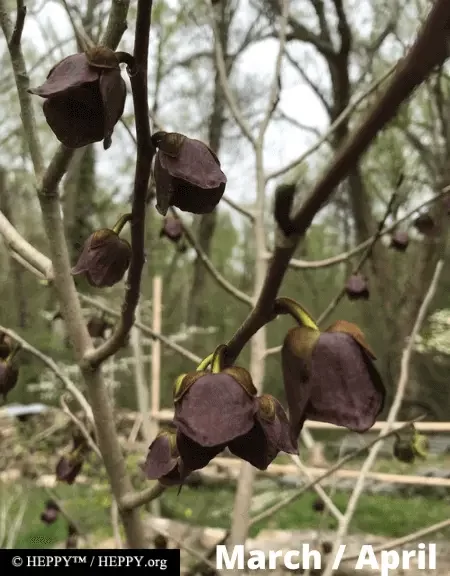

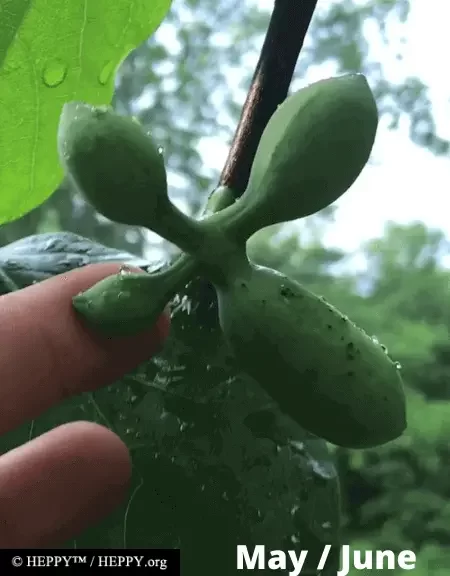

Pruning
Pruning is INFREQUENT. A twig here and a branch there. That’s it. However, the one exception is tip-pruning when you notice the Pawpaw Webworm, Omphalocera munroei. I tip-prune in this 1 minute YouTube vid. Just below is more about pests.
In the wild or at home, they grow in a pyramid-like shape. ONE exception is if they grow in complete shade. The tree will grow lanky (long) in FULL shade.
Pests
Pawpaw are virtually pest and disease free. But it’s not perfect. The good news is that none of the three pests kill the Pawpaw tree.
THREE PESTS that affect Pawpaw Trees:
- Pawpaw Peduncle Borer, Talponia plummeriana. In EARLY spring, the Borer eats the fleshy part of flowers. We have not seen any damage by the Borer. However, it may be an issue in some regions.
- Zebra Swallowtail Butterfly, Protographium marcellus. SUMMERTIME is when this “pest” arrives. However, it’s a very attractive butterfly. Also, I saw very little leaf-loss or leaf-nibble in the years that I saw the caterpillar. It’s too attractive to be a pest. I encourage this insect.
- Pawpaw Webworm, Omphalocera munroei. Terrible! In August-September you may see webs in Pawpaw leaves. BE SURE TO TIP-PRUNE, or REMOVE “webby” leaves as soon as you see it. The leaves will die and the webs spread, and then more leaves die. It can defoliate a tree BUT not kill it. I tip-prune in this 1 minute YouTube vid.
Thinning fruit
Pawpaw fruit grow in clusters. 2 to 8 or more fruit per cluster. Exactly how many clusters to thin is dependent on the tree’s maturity.
For a very young tree (1-3 yrs), I remove all fruit to encourage as much root growth as possible. We think long-term. Also, young trees produce few fruit anyways. Loose fruit in the short-term, and get a healthy tree as soon possible.
For a young tree (3-6 yrs), thin fruit to 10-30 fruit per tree. Keep roughly 3 fruit per cluster.
For a mature tree (7+ yrs), thin only the poorest looking immature fruit. A mature tree in the right conditions will produce a TON of fruit. Let her go!
In general, thinning fruit will cause all fruiting trees to produce larger fruit.
Propagating Pawpaw by seed and grafting
Propagation by seed and grafting are the common methods.
Seeds
Pick and enjoy Pawpaw fruit in Fall (September). Collect its large seeds. However, do not let seeds dry out for too long before planting or storing them.
Also, seeds must stratified (be cold) for 90 to 120 days. NOT frozen but cold.
Stratification Method 1: plant seeds
Seeds can be sown in soil if temps will fall below 35 degrees over your winter-period. At any period in winter, after seeds are sown. Sowing seeds directly into the soil — in pots or in the ground — is efficient. Have your planting area prepared by fall. Pawpaw have long tap roots. So long narrow pots are ideal for healthy roots. We use inexpensive Plastic Nursery Bags.
Stratification Method 2: store seeds
Stratify seeds in a moist medium. Place seeds in a moist paper towel, moist sand or moist peat moss. Place them in a zip lock bag and refrigerate. NEVER freeze Pawpaw seeds.
There are issues with molding (paper towels are more susceptible). Keep an eye on your seeds.
Propagation Protocol: Asimina triloba
Grafting
Once seedlings mature, growers graft-on scion from a selected cultivar. If you don’t know: scion is last year’s growth; it’s harvested in the Winter (February-March); yes, it’s a twig but, contains the genes of the tree it was harvested from. Here’s a 1 minutes video of us harvesting Persimmon scion.
There are many reputable sources to purchase scion from. Our favorite nurseries are listed here (England’s Orchard & Nursery is the best for scion). On facebook you’ll find seasoned growers at North American Pawpaw Growers Association (NAPGA) and Pawpaw Fanatics. Woody Walker is a seasoned grower and supplier. Finally, growingfruit.org has seasoned growers too.
Pawpaw growing at HEPPY
Pawpaw learning curve
The ‘Pawpaw bug’ bit me in 2016. The first Pawpaw trees were purchased from the nearest nursery. It was a LONG drive to find ANY cultivar in the Washington DC region! I purchased the Prolific, Wells, and Seedling of Cultivar (SOC). Looking back, the SOC was a silly purchase at ~$80 for ONE tree. I advise against buying an unnamed cultivar like the “SOC”, BTW. I was a rookie.
I caught my breath, and researched varieties and top nurseries. In 2018 I drove to England’s Nursery in Kentucky! There, I found great prices, varieties and very helpful nurseryman, Cliff England. I also nurture the many native Pawpaw trees that appeared across HEPPY!
Flatten YOUR learning curve
Over the years I learned that Pawpaw seeds germinate like weeds and they grow rather quickly. Seed in high organic soil under partial shade. Also, I’m learning to graft, and to be patient.
Read forums such as growingfruit.org and Pawpaw Chronicles on FB, attend Pawpaw Festivals, and read materials from credible sources (KSU, for example). Inform yourself, accumulate a few years of experience and you’ll be fine! The Pawpaw is truly a low/no-care fruiting tree!
Pawpaw trees we grow
- Jerry’s Big Girl (aka, 250-39). A Jerry Lehman variety.
- Kentucky Champion
- Potomac. A Neil Peterson variety.
- Prolific
- Seedling of Cultivar (SOC)
- Susquehanna. A Neil Peterson variety.
- Wells
And, I look forward to grafting more trees to native Pawpaw trees!
250-39 (aka, Jerry’s Big Girl)
Jerry’s Big Girl won Best Pawpaw in 2013 and 2017 at the Ohio Pawpaw Festival (tasting contest). It also won the Biggest Pawpaw contest 2014. Mr. Jerry Lehman cultivated the “250-39” and many named varieties. Lehman’s Delight (275-48) is another variety that won often at the Ohio Pawpaw Festival.
For us, Jerry Lehman’s Jerry’s Big Girl (JBG) is an absolute stand-out tree. It’s vigor, size and shape is exceptional. We planted three varieties at the same time (same size tree & pot). The JBG grew the fastest and fruited first. It’s shape is perfect. It grows very “full” — it grows as tall as it grows wide.
I found that JBG is least likely to be annoyed by the Pawpaw Webworm (Omphalocera munroei). It’s one of about 3 insects annoy (not kill) the Pawpaw.
It was purchased from England’s Orchard & Nursery.
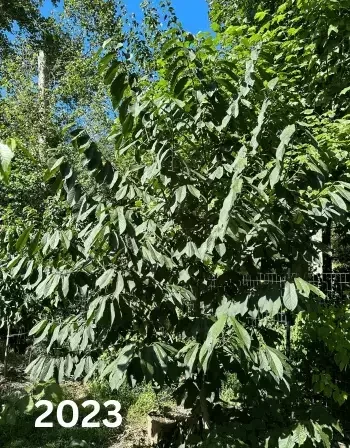
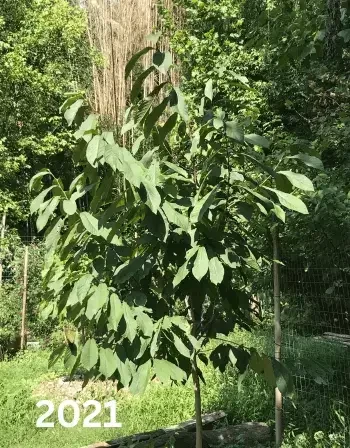
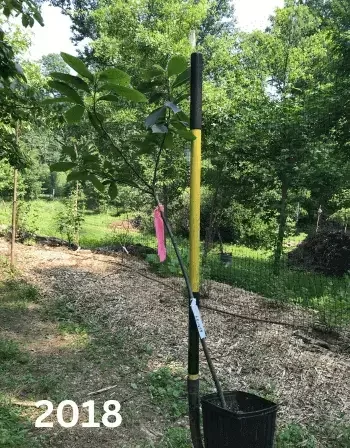
Potomac and Susquehanna
These TWO varieties are named after Neal Peterson. What a fantastic story, and provided us with amazing varieties.
Potomac
Voted Biggest Pawpaw in 2016 & 2017 at the Ohio Pawpaw Festival. It was a very promising tree until a large tree fell on her. She was repaired and is recovering. Our ‘tree repair’ is on YouTube.
It’s described as “extremely fleshy” (~ 4% seed by weight), with a sweet, firm, melting and smooth fruit (the flesh). Medium productivity with fruit size typically 12+ oz. It grows very upright. It is less spreading (wide) than most.
Susquehanna
Voted Biggest Pawpaw in 2009 and Best Pawpaw in 2016 at the Ohio Pawpaw Festival.
SO dispirit to have this variety I purchased a very newly grafted tree. I was warned by Cliff England to take special care of it because it was so small. Well, I did! 😉
Neal Peterson describes it as, “my personal favorite.” It is large, extremely few seeds, and firm melting texture. Quite sweet with strong pawpaw flavor.
The Potomac and Susquehanna were purchased from England’s Orchard & Nursery.

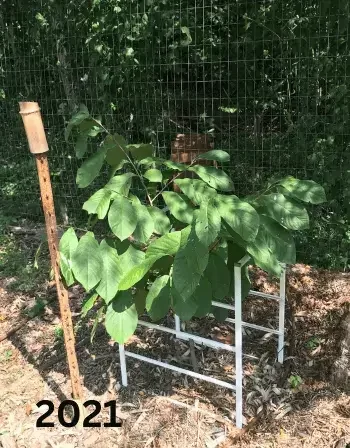
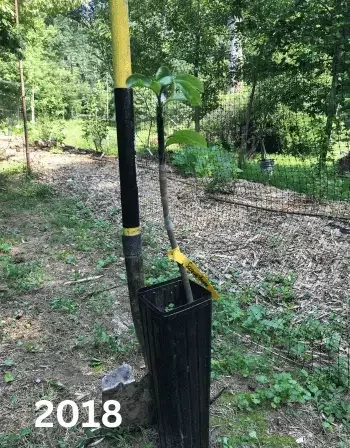
Susquehanna, 2018 – 2023
Other Pawpaw Varieties
Kentucky Champion
I targeted this tree because of its size. It’s the “Big Daddy”. England’s Orchard & Nursery. describes it as:
- Remarkably resilient and responds well to grafting
- Earliest bearing cultivar of all commercially available pawpaw trees.
- Fruit is golden-orange in color with a melon-orange flavor.
- It produces a large fruit with a 8.3% seed-to-pulp ratio.
Our Kentucky Champion Pawpaw was purchased from England’s Orchard & Nursery.
Prolific
The Prolific Pawpaw was identified in the 1980s by Corwin Davis. Davis developed several named varieties of Pawpaw cultivator.
It grows round and short. The Prolific produces medium sized fruit, and fruited when relatively young. It produces a prolific amount of fruit.
Our Prolific Pawpaw was purchased from Sun Nursery.
Wells
The Wells Pawpaw was collected from the wild in Salem, Indiana. David K. Wells found it in 1990. Kentucky State University developed the cultivar.
It’s a very upright tree — narrow and tall, is how I’d describe it. It produces large fruit and fruited when relatively young.
The Wells was purchased from Sun Nursery.
Seedling of Cultivar (SOC)
I recommend NOT buying a unnamed tree. There are TOO many nurseries, festivals and other options to find quality trees. Our SOC could be any-ol’ tree.
It took many years to start fruiting. She grows rather large. It has the classic shape of a Pawpaw tree — the shape of a Christmas tree. Years later she began fruiting. It bears a good crop of medium-large fruit.
I purchased the SOC in desperation. I was bit by the ‘Pawpaw Bug’ and had to plant cultivars. I drove to the closest nursery with pawpaw — in the entire Washington DC region. It was a one-hour drive! I found the Prolific, Wells and this girl. I paid $80 for one tree! That’s ‘bit bad’ by the Pawpaw Bug. The SOC was purchased from Sun Nursery.
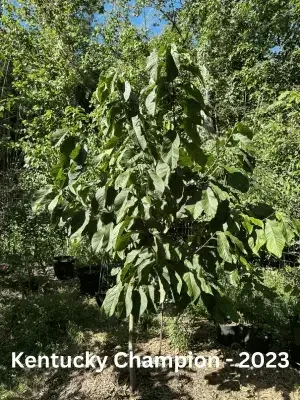
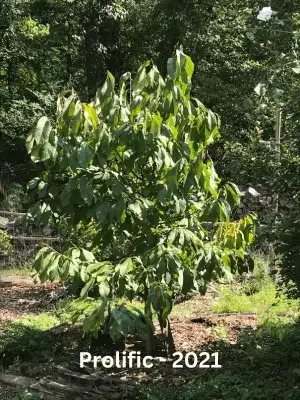
In 2017, we found a large farm of pawpaw trees. The farmer had many acres of mature trees in Northern Virginia. I purchased two very small tress: a Davis and Pennsylvania Golden Pawpaw. However, they I didn’t overwinter them correctly. They died but it was a lesson well-learned! VERY small pawpaw tress IN pots must be overwintered carefully. Now, our method is to bury the entire pot into the soil and then place 4-6 inches of wood chips around each potted plant. All plants.
There is so much more to write about the Pawpaw! I have charts, and grafts of the best producing trees, seed ratios, and more. Volunteer at, or donate to HEPPY to move this project along!
Pawpaw Festivals, 2024
Find a Pawpaw Festival near you. They are in Eastern US States. And there’s some new festivals. Most festivals occur in September.
Festivals are excellent family fun, or for individuals who want to hang-out. View commercial opportunities, buy a variety of fruiting plants as well as Pawpaw trees. Enjoy vendors selling a variety of natural products, exchange information, and meet artisans and like-minded people.
COVID changed things. For example, Washington DC held its FIRST annual Pawpaw festival in 2019. However, it never returned. In 2020, all Pawpaw festivals were cancelled. In 2021, a few Pawpaw festivals opened. It was GREAT to see the Ohio Pawpaw Festival and York County Pawpaw Festival open! Thank you! By 2022, the large Pawpaw Festivals were back :).
Now, 2024 Festivals are set! And there’s new ones. The Pawpaw “bug” is back!
*** click on any festival to DOUBLE check the dates, when they open/close, or to pre-order tickets!
*** the Kentucky State University (KSU) International Pawpaw Conference is truly special. it’s not annual by design. online are the 2016, Conference Program Presentations of the KSU THE FOURTH INTERNATIONAL PAWPAW CONFERENCE. the presentations are a terrific, educational read.
the KSU Pawpaw festival occurs approximately every 5 years (it varies, KSU fests occurred in 2001, 2011, and 2016). 2016 is the year I caught “the pawpaw bug” and assumed the event was annual. i’ll be ready for the next one.






